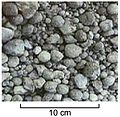Ceramic nanoparticle is a type of nanoparticle that is composed of ceramics, which are generally classified as inorganic, heat-resistant, nonmetallic solids...
10 KB (1,100 words) - 19:11, 22 April 2024
all visible light incident on them. Nanoparticles also easily pass through common filters, such as common ceramic candles, so that separation from liquids...
125 KB (12,946 words) - 10:45, 21 October 2024
targets Ceramic engineering – Science and technology of creating objects from inorganic, non-metallic materials Ceramic nanoparticle Ceramic matrix composite –...
44 KB (5,243 words) - 22:32, 29 October 2024
Silver nanoparticles are nanoparticles of silver of between 1 nm and 100 nm in size. While frequently described as being 'silver' some are composed of...
97 KB (12,152 words) - 06:10, 29 October 2024
Colloidal gold (redirect from Gold nanoparticle)
Colloidal gold is a sol or colloidal suspension of nanoparticles of gold in a fluid, usually water. The colloid is coloured usually either wine red (for...
85 KB (9,821 words) - 15:36, 13 October 2024
Sol–gel process (category Ceramic engineering)
precursors are metal alkoxides. Sol–gel process is used to produce ceramic nanoparticles. In this chemical procedure, a "sol" (a colloidal solution) is formed...
30 KB (3,801 words) - 08:05, 6 June 2024
lipids. They are a novel pharmaceutical drug delivery system (part of nanoparticle drug delivery), and a novel pharmaceutical formulation. Using LNPs for...
24 KB (2,687 words) - 18:59, 5 October 2024
A copper nanoparticle is a copper based particle 1 to 100 nm in size. Like many other forms of nanoparticles, a copper nanoparticle can be prepared by...
13 KB (1,389 words) - 09:25, 2 September 2024
Ceramic engineering is the science and technology of creating objects from inorganic, non-metallic materials. This is done either by the action of heat...
58 KB (7,461 words) - 13:02, 6 September 2024
Platinum nanoparticles are usually in the form of a suspension or colloid of nanoparticles of platinum in a fluid, usually water. A colloid is technically...
45 KB (5,347 words) - 22:26, 30 June 2024
Aluminium oxide (redirect from Alumina ceramic)
molybdenumdisulfate to provide long term lubrication of the surface. Aluminium oxide nanoparticle Bauxite tailings Beta-alumina solid electrolyte, a fast ion conductor...
36 KB (3,589 words) - 02:48, 29 October 2024
Iron–platinum nanoparticles (FePt NPs) are 3D superlattices composed of an approximately equal atomic ratio of Fe and Pt. Under standard conditions, FePt...
14 KB (1,426 words) - 15:45, 7 May 2024
Nanocomposite (section Ceramic-matrix nanocomposites)
acid) (PLGA), and poly(glycerol sebacate) (PGS). A range of nanoparticles including ceramic, polymeric, metal oxide and carbon-based nanomaterials are...
29 KB (3,506 words) - 19:58, 26 July 2024
Titanium dioxide nanoparticles, also called ultrafine titanium dioxide or nanocrystalline titanium dioxide or microcrystalline titanium dioxide, are particles...
24 KB (2,537 words) - 02:10, 24 September 2024
Magnetically assisted slip casting (category Nanoparticles)
is a manufacturing technique that uses anisotropic stiff nanoparticle platelets in a ceramic, metal or polymer functional matrix to produce layered objects...
3 KB (394 words) - 15:10, 27 February 2022
Iron oxide nanoparticles are iron oxide particles with diameters between about 1 and 100 nanometers. The two main forms are composed of magnetite (Fe3O4)...
25 KB (2,968 words) - 11:37, 20 February 2024
(nanosized alumina) occurs in the form of spherical or nearly spherical nanoparticles, and in the form of oriented or undirected fibers. Properties, of the...
8 KB (1,010 words) - 16:09, 26 October 2023
Nanotechnologies (global) Cerion Nanomaterials, Metal / Metal Oxide / Ceramic Nanoparticles (US) OCSiAl, Carbon Nanotubes (Luxembourg) Phaedon Avouris - first...
13 KB (1,056 words) - 02:21, 8 November 2024
Aquasome (category Nanoparticles)
Aquasomes are self-assembling nanoparticle drug carrier systems composed of three layers: a ceramic core, an oligomer coat, and a loaded biochemically...
23 KB (2,848 words) - 06:22, 27 September 2024
Ferrite (magnet) (redirect from Ceramic Magnet)
A ferrite is one of a family of iron oxide-containing magnetic ceramic materials. They are ferrimagnetic, meaning they are attracted by magnetic fields...
34 KB (3,753 words) - 13:02, 15 September 2024
and active safety measures across multiple layers. AMAP utilizes ceramic nanoparticles, providing lightweight yet durable armor. It has been installed...
6 KB (604 words) - 20:10, 5 November 2024
Sintering (section Ceramic sintering)
"pressureless sintering", which is possible with graded metal-ceramic composites, utilising a nanoparticle sintering aid and bulk molding technology. A variant...
51 KB (7,041 words) - 09:16, 20 October 2024
specialized applications. Hodes, Gary (2007-05-09). "Semiconductor and ceramic nanoparticle films deposited by chemical bath deposition". Physical Chemistry...
15 KB (1,886 words) - 07:29, 30 September 2024
into the polymer from which the fabric is manufactured. Bioceramic nanoparticles are added to the fused polymer. Some types of ceramics show thermally-induced...
5 KB (703 words) - 01:23, 9 May 2022
within a few nanometers, the surface area of the same amount of a mass of a ceramic greatly increases. So in general, nanophase materials have greater surface...
9 KB (1,061 words) - 01:49, 30 June 2022
nanometer sizes. For example, nanoparticles of usually yellow gold and gray silicon are red in color; gold nanoparticles melt at much lower temperatures...
40 KB (5,369 words) - 06:48, 29 October 2024
using silver nanoparticles as an antibacterial agent, nanoparticle-based sunscreens, carbon fiber strengthening using silica nanoparticles, and carbon...
69 KB (7,035 words) - 22:52, 18 October 2024
Dip-coating (section Nanoparticle coatings)
a thermal treatment to tailor the material properties of the solid. Nanoparticle deposition Sol-gel Coatings Scriven, L.E. (1988). "Physics and applications...
7 KB (909 words) - 20:14, 5 October 2023
Nanomaterials (section Nanoparticles)
be nanoparticles, other sources use the term nanoparticle for all shapes. Nanoparticles have all three dimensions on the nanoscale. Nanoparticles can...
86 KB (10,267 words) - 12:43, 17 June 2024
through ground water, allowing for in situ treatment. Additionally, the nanoparticle-water slurry can be injected into the contaminated area and stay there...
3 KB (354 words) - 23:38, 8 February 2022














